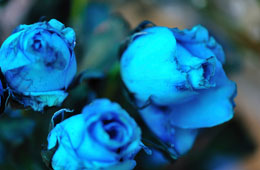Though there's a huge demand for red roses in the market due to its beauty and association with love, there's an element of mystery to the blue-colored roses as they are rare. This write-up provides information on blue roses.

A rose is a beautiful creation of nature, with those velvety petals and mild fragrance. The beauty of this flower has inspired many authors and poets. This flower comes in several colors ranging from red, pink, white, purple, yellow, etc. Some of the rare colors are a result of cross-breeding two types of roses. Amongst all types and colors, there is an element of mystery about the blue roses.
Do Blue Colored Roses Exist?
The traditional process of making faux blue roses involved dyeing white roses with blue pigment. However, such roses seemed less natural. The truth is that blue roses were not available originally in nature until 2004. The credit goes to the combined efforts of an Australian and a Japanese research company for genetically developing one.
Genetic engineers from Australia and Japan tried hard to produce blue colored roses in a natural environment. The foremost obstacle in their way was to create
delphinidin, an anthocyanin in the rose flowers that produces blue pigmentation. In 2004, after thirteen years of research, the scientists were able to artificially induce the blue color in the plant pigmentation. The scientists cloned the plant pigmentation from the flower 'petunia', into the 'Cardinal de Richelieu, which is a type of rose with bright purple color. Unfortunately, the extracts of cyanidin, which is an anthocyanin responsible for the darker shades of flowers, were still causing certain trouble. Currently, with the help of advanced RNAi technology, it has become almost possible to lower the effect of cyanidin in the plant pigments. The scientists were finally successful in inducing a purplish hue. The process is still going on with the hope of creating the perfect blue-colored rose.
Significance
In many cultures, blue roses signify mystery and a journey to achieve the impossible dreams. These plants are produced for a wide range of reasons. Some serve as an cascading bush variety, while others are grown for fragrance. One can also plant the modern hybrid tea roses to get a pale lavender hue. Of course, they are not really blue in color because the actual blue roses are extremely rare.
Though many gardening enthusiasts would love to grow this flower, these are very uncommon. More often than not, plants that produce similar looking flowers are grown. The most popular amongst them is the 'veilchenblau plant', which is also called blue moon rose. Many people prefer to grow the lilac or lavender rose plant, as it is almost without prickles and has a light green foliage and upright growth. These flowers are very fragrant. Even baby rose plants are readily available. These flowering plants require the same gardening techniques and tender care as the ordinary roses.






 A rose is a beautiful creation of nature, with those velvety petals and mild fragrance. The beauty of this flower has inspired many authors and poets. This flower comes in several colors ranging from red, pink, white, purple, yellow, etc. Some of the rare colors are a result of cross-breeding two types of roses. Amongst all types and colors, there is an element of mystery about the blue roses.
A rose is a beautiful creation of nature, with those velvety petals and mild fragrance. The beauty of this flower has inspired many authors and poets. This flower comes in several colors ranging from red, pink, white, purple, yellow, etc. Some of the rare colors are a result of cross-breeding two types of roses. Amongst all types and colors, there is an element of mystery about the blue roses.